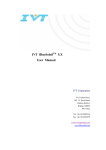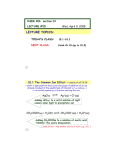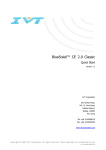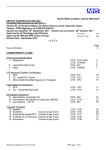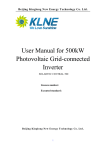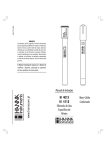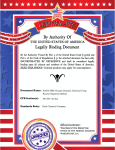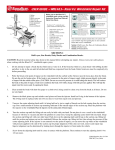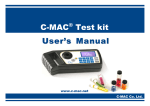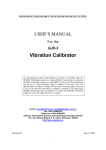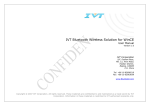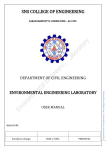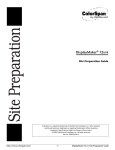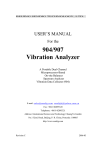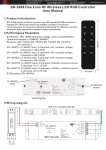Download SC-2 COD Tester User manual
Transcript
SC-2 COD Tester User manual Beijing ChinaInvent Instrument Tech. Co.,Ltd http://www.ChinaInvent.com th Add: 8 Floor, NO.2 Xinxi Road, ShangDi, HaiDian District, Beijing China 100085 Tel: 010-82896091 Fax: 010-82896091-8099 Table of contents Safety information...................................................................................................................................... 2 Specifications ............................................................................................................................................... 3 Operation.................................................................................................................................................... 4 Section 1 General information .................................................................................................................. 5 1.1 Instrument description............................................................................................................................ 5 1.2 Determination range............................................................................................................................... 5 1.3 Principle ................................................................................................................................................. 5 1.4 Unpacking the instrument ...................................................................................................................... 5 1.5 Instructions of keyboard..................................................................................................................... 6 Section 2 Set menu items ........................................................................................................................... 7 2.1 Menu ...................................................................................................................................................... 7 2.2 Set time .................................................................................................................................................. 7 2.3 Database................................................................................................................................................. 7 2.4 Set curve................................................................................................................................................. 7 Section 3 Operation.................................................................................................................................... 9 3.1 Reagent preparation ............................................................................................................................... 9 3.1.7 Standard stock solution ..................................................................................................................... 10 3.2 Digestion .............................................................................................................................................. 11 3.3 Zero calibration .................................................................................................................................... 12 3.4 Sample determination .......................................................................................................................... 13 3.5 Adjust the working curve ..................................................................................................................... 13 3.6 Quality assurance ................................................................................................................................. 13 Section 4 Maintenance ............................................................................................................................... 14 4.1 General Maintenance ........................................................................................................................... 14 4.2 Cleaning the colorimetric cell .............................................................................................................. 14 4.3 Replacement guide ............................................................................................................................... 14 Section 5 Troubleshooting ....................................................................................................................... 15 1 Safety information Please read this entire manual before unpacking, setting up, or operating this equipment. Pay attention to all danger and caution statements. Failure to do so could result in serious injury to the operator or damage to the equipment.To ensure that the protection provided by this equipment is not impaired, do not use or install this equipment in any manner other than that specified in this manual. Use of Hazard Information DANGER: Indicates a potentially or imminently hazardous situation which, if not be avoided, could result in death or serious injury. CAUTION: Indicates a potentially hazardous situation that may result in minor or moderate injury. NOTE: Information that requires special emphasis. 2 Specifications Specifications are subject to change without notice. Wavelength accuracy ±3 nm Wavelength 440nm 595nm Wavelength selection automatic Transmittance accuracy ±2.0%T Accuracy repeatability ±0.5%T Disturbance resistance of chloride ion ≤1200mg/L Digestion temperature 165℃±1.5℃ Drift < 0.002A in 20mim Light resource LED Filter interference filter Detector silicon photodiode display wide screen LCD, 240*128 Reading model %Transmittance, absorbance, concentration Digestion temperature accuracy ±2℃ Output USB and RS-232,configurable printer Power supply 220VAC or 380VAC Dimensions 380*280*120mm Weight 4Kg Luminosity range 0-2A Temperature range operation: 0-50℃ storage: -40-60℃ humidity below 85% Environment comply with IP67 standard 3 Operation Danger It may be dangerous to treat the chemical samples, standard substance and reagent. Please look over the security information before dealing with any chemical substance. 4 Section 1 General information 1.1 Instrument description The tester is a photometer that is controlled by a microprocessor with LED light source and filter. It is suitable for laboratory or on-site color testing. The instrument has been pre-calibrated towards the ordinary color testing. The features of tester are as follows: • The result is displayed by concentration, absorbance or transmission • The data storage and query is carried out in laboratory or on-sit •Take power adapter as power supply 1.2 Determination range For the undiluted water sample, the detection range of COD is 15~1000 mg/L, and the concentration of chloride ion should lower than 1000 mg/L; while the COD value is beyond 1000 mg/L or the concentration of chloride ion exceed 1000 mg/L, the sample must be diluted. 1.3 Principle Add known amount of potassium dichromate solution in the sample. Taking silver sulfate as a catalyst, the COD value is determined by spectrophotometry in strong sulfuric acid medium, after high temperature digestion. Principle: in the high range of COD values (100~1000mg/L), measure the absorbency of trivalent chromium reduced at 600nm wavelength. According to the principle that the COD value is proportionate to the increase value of trivalent chromium absorbency, convert the absorbency into COD value. While in the low range of COD value (15~150mg / L), measured the total absorbency of hexavalent chromium not reduced and trivalent chromium reduced at 440nm wavelength. In accordance with the direct ratio of the decrease value of total absorbency with COD value, calculate the COD value. 1.4 Unpacking the instrument Remove the COD tester from its shipping carton and inspect it for any visible damage. Contact Chinainvent Customer Service at +86-10-82896091 if any items are missing or damaged. 1.4.1 Parts and accessories • 1cm glass colorimetric cell(low range),2cm glass colorimetric cell(high range) 5 • Digestion tube • AC adapter • File pack— user manual, appendix, product conformity certificate, packing list 1.5 Instructions of keyboard Key Description MENU select a program, containing time set/ database/curve calibration TEST test the sample, including two items of high range and low range ENTER carry out the order selected DEL delete the data BACK to backtrack to higher menu ← to move the cursor to the left → to move the cursor to the right ↑ move the cursor upwards; input number ↓ move the cursor downwards; input number 6 Section 2 Set menu items 2.1 Menu Start up the instrument, and press “menu”. Such three items as “set time”, “database” and “curve calibration” display in the menu interface. Press “↑” or “↓” to move the cursor to specific item, and press “ENTER” to enter in. 2.2 Set time Set date and time to get a correct date and time of data storage and query. Press “menu” , select “set time”, press “→” or “←”to move cursor, and press “↑” or “↓” to revise date and time; press “ENTER” to set date and time successfully. 2.3 Database Inquire or delete the history data in database menu. 2.4 Set curve Set curve in high-range or low-range with the same method. There are three methods to establish curves, such as determination of standard sample, input of slope and intercept, and input of absorbance and concentration. 2.4.1 Determination of standard sample Press “→”, “←”, “↑”or“↓” to input a group of standard sample concentration following the prompts(the tester could set six standard samples, press “ENTER” after completing input; according to the clew, put in blank solution, test it, and then press “ENTER” after finishing test. Following the prompts, put the sta. sample to test absorbance in turn, and press “ENTER” after the last sta. sample is determined; input the curve serial NO. and press “SAVE”. Press “BACK” to test afresh. Note:Curve serial NO. in low range, L1---L5; curve serial NO. in high range, H1---H5 2.4.2 Input of slope and intercept There are five built-in curves in the instrument. Press “↑”or “↓”to select a curve, and press “ENTER” to enter in the curve modification interface; press “→”or “←” to choose the item to be revised, and press 7 “↑”or “↓”to modify the slope and intercept; press “ENTER” after completing revise. 2.4.3 Input of absorbance and concentration Setting curves in high-range or low-range display as follows: Sta. sample 1 C1: ****.** A1: *.**** Sta. sample 2 C2: ****.** A2: *.**** Sta. sample 3 C3: ****.** A3: *.**** Sta. sample 4 C4: ****.** A4: *.**** Sta. sample 5 C5: ****.** A5: *.**** Sta. sample 6 C6: ****.** A6: *.**** Press “→”,“←”,“↑”or“↓” to input a group of concentration and absorbance of sta. sample having determined(C1---C6;A1---A6). Press “ENTER” after finishing input, and input the curve serial NO. (H1---H5 or L1---L5. Press “SAVE” to store the sta. curve, and press “BACK” to test afresh. 8 Section 3 Operation 3.1 Reagent preparation 3.1.1 Water Should comply with relevant rules of Ι class water -GB/T6682 sulfuric 3.1.2 Sulfuric acid:ρ(H2SO4)=1.84g/mL. 3.1.3 Sulfuric acid solution:(1+9). Slowly add 100mLof sulfuric acid(3.1.2)in 900mL water along breaker wall, stir to even,and cool it down. 3.1.4 Catalyst—silver sulfate - Sulfuric acid solution:ρ(Ag2SO4)=10g/L. Add 5.0g of silver sulfate to 500mL Sulfuric acid( 3.1.2, stand for 1-2 days, stir it to fully dissolve. 3.1.5 Masking agent ---- mercuric sulfate solution:ρ(HgSO4)=0.24g/mL. Add 48.0g of mercuric sulfate to 200mL Sulfuric acid solution( 3.1.3), stir it to fully dissolve, it can be stable for 6 months. 3.1.6 Oxidant 3.1.6.1 (High-range)potassium dichromate standard solution:C(1/6 K2Cr2O7)=0.500mol/L Dry potassium dichromate to constant weight at 120℃±2℃,weight 24.5154g potassium dichromate and add it into breaker,pour in 600mLwater,gradually add 100mL sulfuric acid(3.1.2), stirring meantime. After it fully dissolve, transfer that solution to 1000mL volumetric flask, fill to the mark with water, shake it even. It can be stable for 6 months. 3.1.6.2 (Low-range)potassium dichromate standard solution:C(1/6 K2Cr2O7)=0.120mol/L. Dry potassium dichromate to constant weight at 120℃±2℃,weight 5.8837g potassium dichromate and add it into breaker,pour in 600mLwater,gradually add 100mL sulfuric acid(3.1.2), stirring meantime, 9 After it fully dissolve, transfer that solution to 1000mL volumetric flask, fill to the mark with water, and shake it even. It can be stable for 6 months. 3.1.7 Standard stock solution 3.1.7.1 (High-range)potassium acid phthalate (KAP) COD standard stock solution:COD 5000mg/L. Dry KAP to constant weight at 105℃~110℃,weight 2.1274g KAP , add it into the breaker with 250mL water, and stir it; after it fully dissolve, transfer that solution to 500mL volumetric flask, fill it to the mark with water, and shake it even. It should be stored at 2℃~8℃; if adding 10mL sulfuric acid solution (3.1.3)in the solution before fixing volume, it can be stable for 1 month in normal temperature. 3.1.7.2 (Low-range) potassium acid phthalate (KAP)COD standard stock solution:COD 625mg/L。 Pour 25.00mLCOD standard stock solution to 200mL volumetric flask, fill it to the mark with water, and shake up. It is stable for 1 month at 2℃~8℃ 3.1.8 KAP COD standard serial using solution 3.1.8.1 COD standard serial using solution in high range: 100 mg/L, 200 mg/L, 400 mg/L,600 mg/L, 800 mg/L, 1000 mg/L. Add COD standard stock solution (3.1.7.1)of 10.00mL,20.00mL,30.00mL, 40.00mL, 50.00mL into 250mL volumetric flask individually; fill it to the mark with water ,and shake up. It is stable for 1 month at 2℃~8℃. 3.1.8.2 COD standard serial using solution in low range: 25 mg/L, 50 mg/L,75 mg/L,100 mg/L,125 mg/L,150 mg/L. Add COD standard stock solution (3.1.7.2)of10.00mL,20.00mL,30.00mL, 40.00mL 50.00mL and 60.00mL into 250mL volumetric flask individually, fill it to the mark with water ,and shake up. It is stable for 1 month at 2℃~8℃. Note: the concentration of KAP standard solution could be different with that in this manual as required. The concentrations in this manual are for general reference only. 10 3.2 Digestion 3.2.1 Cleaning the digestion tube The digestion tube of first use, should be cleaned as the following method: Add the appropriate amount of mixture that consists of six portions of silver sulfate - sulfuric acid solution (3.1.4) and one portion of potassium dichromate (3.1.6.1) in the digestion tube, tighten the cap, heat it at 60 ℃ ~ 80 ℃ water bath, and repeatedly wash the inside wall. After cooling it to room temperature, unscrew the lid, pour out the mixture, rinse the cover and inside and outside wall of the digestion tube with water. 3.2.2 The mixture of reagent with sample Before digesting, add specific ratio of reagent and sample as the table below to the digestion tube, tighten the lid and gently shake up and down several times to complete mix. Put the tube in digestion tank on the left of the instrument for15min at 165 ℃. Potassium Colorimetric Silver sulfateMercuric bichromate Range cell sulfuric acid Sample sulfate(3.1.5) (3.1.4) high range 1.00mL 2cm (100-1000)mg/L 0.50mL 6.00mL 3.00mL 0.50mL 6.00mL 3.00mL (3.1.6.1) 1.00mL low range 1cm (3.1.6.2) (15-150)mg/L 3.2.3 Instruction of digester 3.2.3. 1 Specifications Heating range: 20~200℃ Resolution ratio: 1℃ Accuracy: ±2℃ Digestion temperature: 165℃ Digestion time: 15min. 11 3.2.3.2 3.2.3.2.1 Digester interface and keyboard Main interface after starting up : Current tem.: XXX ℃ Set tem.: XXX ℃ Diges. time: XXX min *set parameter* “Current tem.” is the actual temperature in the process of warming up; “Set tem.”is the digestion temperature required; “Diges. time” is the digestion time required 3.2.3.3.2 Press “mode”, the interface displays four items as follows: *set parameter*, *constant tem.*, *start to diges. * and *cooling*. Press “ENTER” to enter in the mode selected (1)* set parameter *:press “ENTER” to enter in the items of “Set tem.”and “Diges. time”. Press “◄” or “►” to adjust it and press “ENTER” to confirm the set. (2)* constant tem.*:heat the instrument to the temperature set and keep it constant. (3)* start to diges.*:begin to digest the sample (4)*cooling*:after finishing digestion, take out digestion tube and make the digester cool down. 3.2.3.4 Usage of tester Start up the tester, it enters in main interface automatically. Set the digestion temperature and time as 3.2.3.3.2; select the mode of “Current tem.”, put the tube in heating hole when the current temperature rise to the set temperature, cover the lid; select the mode of *start to diges. *, and press “ENTER” to begin to digest the sample. The tester will prompt the achievement of digestion with three-time buzzing, when reach to digestion time, take out of digestion tube, and start to measure it when the solution cooling off. Note:please fix the lid on in the process of digestion, so that not to be injured because of the solution boiling away and splashing, be careful not to be scalded when get out the tube. 3.3 Zero calibration The instrument should be calibrated zero before conducting each or a series of experiments, to ensure the zero reference on the measurement process. After starting up, put the blank solution (distilled water) in colorimetric tank, press “ TEST” to select high or low range, and select a curve. Then the tester conduct self-checking, and it will automatically measure the blank solution subsequently. 12 3.4 Sample determination When digestion is over, get out the tube and cool it down to room temperature. Pour digestion solution to a colorimeric cell, pour blank solution to another cell. After finishing zero calibration as 3.2, the screen displays “continue to test”, “quit testing”. when the cursor is shown on “continue to test”, press “ENTER”. The notice—please put in the solution tested, and press ENTER—appears, then put the cell with sample in colorimetric tank, finally press “ENTER” to determine it. The result contains concentration,transmittance and absorbance, and the user could choose “continue to test”, “quit testing” and “save data” at this time. Note:Use 2cm colorimetric cell in high range, while 1 cm cell is used in low range 3.5 Adjust the working curve Usually, each curve which is calibrated comprehensively under the ideal condition can meet the needs of the majority of experiments. Deviation of the curve may result from the use of experimental reagent, defective sample cell, procedure error, technical errors and other errors, there may be interfering substances which is out of control of the operator and other reasons. The section of “set curve” ( see 3.4) tell us how to create and store a new working curve. Before adjust the calibration curve, please consider the following questions: 1. The experimental results will be improved because of the adjustment of the curve 2. Whether there is always interference substance in all samples to be tested. 3.6 Quality assurance The specified reference material (neutral filter) which were used usually by the JJG178-2007 UV, visible and near-infrared spectrophotometer can quickly validate the device performance. According to the frequency proposed by laboratory quality assurance procedures, we can use these neutral filters to measure the absorbance on the instrument anywhere and anytime. 13 Section 4 Maintenance 4.1 General Maintenance Clean the shell by wet wipes. Eliminate any reagent spilled out quickly. If the reagent spills out onto sample cell, please use the cotton sticks to clean it. Keep both the colorimetric tank and colorimetric cell clean at any time. Use the lens wipe or soft non-pilling cloth to wipe the cell surface. 4.2 Cleaning the colorimetric cell Clean the colorimetric cell by detergent at first; then rinse with water several times; finally, washes it by deionized water thoroughly. Some sample cells may need to be washed by acid detergent or special cleaning procedures, please refer to procedure manual to obtain more information. Before detergent cleaning, use organic solvents (such as chloroform, benzene, toluene, acetone, etc.), which could be also used in the last washing. 4.3 Replacement guide Turn off the instrument before exchange the batteries, avoiding electrostatic damage. 14 Section 5 Troubleshooting Service department will be responsible for instrument maintenance. Do not open the instrument without permission, otherwise the quality assurance will be canceled. 15

















